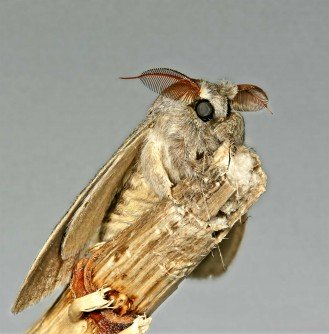Invasive Insects Cost the World Billions Per Year

Credit: Dimitri Geystor (France) One of the most destructive pests of hardwood trees, the Gypsy moth (Lymantria dispar).
Researchers from the University of Adelaide in Australia and CNRS and Paris-Sud University in France have compiled the first comprehensive and robust database of the global economic costs of invasive insects ─ but say estimates are likely to be greatly under-estimated because of the lack of research into costs in many parts of the world.
Previous estimates have been “spatially incomplete and of questionable quality”.
Published in the journal Nature Communications, the researchers report a minimum US$70billion a year cost globally to goods and services, and more than US$6.9 billion a year on health costs of invasive insects.
“Most of the damage to human industry occurs in agriculture and forestry ─ damage and loss of production but also costs of clean-up, eradication and prevention,” says Professor Corey Bradshaw, Sir Hubert Wilkins Chair of Climate Change at the University of Adelaide’s Environment Institute. “But billions of dollars are spent on the treatment and prevention of infectious diseases like dengue, West Nile virus and chikungunya disease spread by insects that have invaded other countries.”
Among the costly insects are the Formosan subterranean termite (Coptotermes formosanus) transported worldwide from eastern Asia and capable of consuming as much as 400 g of wood a day, and the gypsy moth (Lymantria dispar), of Eurasian origin, which is one of the most destructive pests of hardwood trees.
The researchers report that these costs are probably just “the tip of the largely unseen and unmeasured iceberg” because many regions of the world, such as Africa and South America, have yet to measure and estimate many of these costs.
Correcting for minimal sampling bias could bring total annual global costs of invasive insects as high as US$270 billion.
“Ultimately, the average citizen pays for most of these costs, but we can generally reduce the costliest sorts of damage by investing in better detection and early eradication measures,” says Professor Bradshaw.
The researchers say that costs are also likely to increase.
“There are two main phenomena leading to an increased frequency of introductions and potentially expanding distributions of the costliest insect invaders: international trade and global warming,” says Dr Franck Courchamp, Senior CNRS Researcher at Systematic Ecology and Evolution Laboratory (CNRS/Paris-Sud University/AgroParisTech).
“In addition to improving guidelines for estimating the full costs of invasive insects, vigilant planning, public-awareness campaigns and community participation could potentially relieve society of billions of dollars of annual expense, and reduce a great deal of human suffering.”
The research was supported by Foundation BNP Paribas, ANR InvaCost and the Australian Research Council.
Media Contact:
Professor Corey Bradshaw, University of Adelaide, Mobile: +61 (0) 400 697 665, corey.bradshaw@adelaide.edu.au
Dr Franck Courchamp, CNRS, Mobile: +33 16915 5685, franck.courchamp@u-psud.fr
Robyn Mills, Media Officer, Phone: +61 8 8313 6341, Mobile: +61 (0)410 689 084, robyn.mills@adelaide.edu.au
Media Contact
All latest news from the category: Ecology, The Environment and Conservation
This complex theme deals primarily with interactions between organisms and the environmental factors that impact them, but to a greater extent between individual inanimate environmental factors.
innovations-report offers informative reports and articles on topics such as climate protection, landscape conservation, ecological systems, wildlife and nature parks and ecosystem efficiency and balance.
Newest articles

First-of-its-kind study uses remote sensing to monitor plastic debris in rivers and lakes
Remote sensing creates a cost-effective solution to monitoring plastic pollution. A first-of-its-kind study from researchers at the University of Minnesota Twin Cities shows how remote sensing can help monitor and…

Laser-based artificial neuron mimics nerve cell functions at lightning speed
With a processing speed a billion times faster than nature, chip-based laser neuron could help advance AI tasks such as pattern recognition and sequence prediction. Researchers have developed a laser-based…

Optimising the processing of plastic waste
Just one look in the yellow bin reveals a colourful jumble of different types of plastic. However, the purer and more uniform plastic waste is, the easier it is to…



